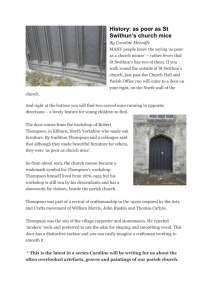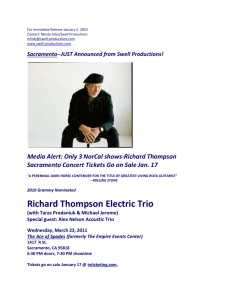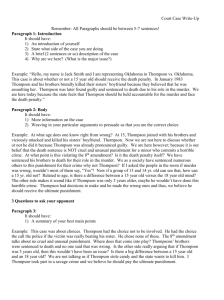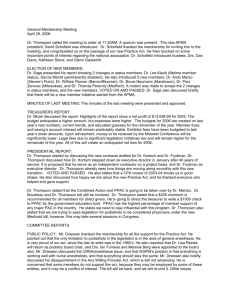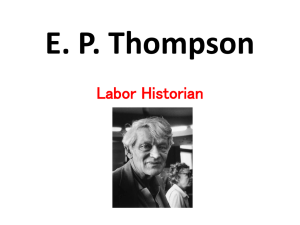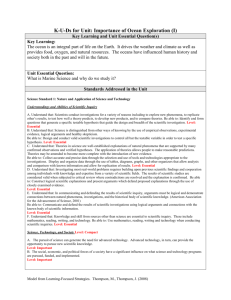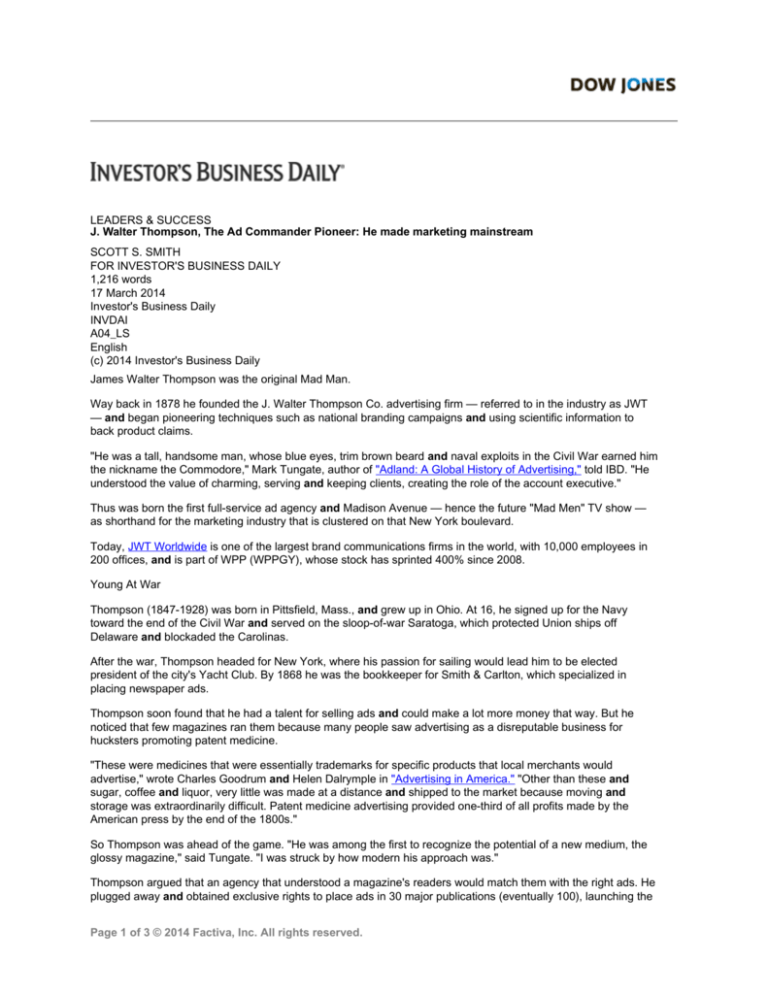
LEADERS & SUCCESS
J. Walter Thompson, The Ad Commander Pioneer: He made marketing mainstream
SCOTT S. SMITH
FOR INVESTOR'S BUSINESS DAILY
1,216 words
17 March 2014
Investor's Business Daily
INVDAI
A04_LS
English
(c) 2014 Investor's Business Daily
James Walter Thompson was the original Mad Man.
Way back in 1878 he founded the J. Walter Thompson Co. advertising firm — referred to in the industry as JWT
— and began pioneering techniques such as national branding campaigns and using scientific information to
back product claims.
"He was a tall, handsome man, whose blue eyes, trim brown beard and naval exploits in the Civil War earned him
the nickname the Commodore," Mark Tungate, author of "Adland: A Global History of Advertising," told IBD. "He
understood the value of charming, serving and keeping clients, creating the role of the account executive."
Thus was born the first full-service ad agency and Madison Avenue — hence the future "Mad Men" TV show —
as shorthand for the marketing industry that is clustered on that New York boulevard.
Today, JWT Worldwide is one of the largest brand communications firms in the world, with 10,000 employees in
200 offices, and is part of WPP (WPPGY), whose stock has sprinted 400% since 2008.
Young At War
Thompson (1847-1928) was born in Pittsfield, Mass., and grew up in Ohio. At 16, he signed up for the Navy
toward the end of the Civil War and served on the sloop-of-war Saratoga, which protected Union ships off
Delaware and blockaded the Carolinas.
After the war, Thompson headed for New York, where his passion for sailing would lead him to be elected
president of the city's Yacht Club. By 1868 he was the bookkeeper for Smith & Carlton, which specialized in
placing newspaper ads.
Thompson soon found that he had a talent for selling ads and could make a lot more money that way. But he
noticed that few magazines ran them because many people saw advertising as a disreputable business for
hucksters promoting patent medicine.
"These were medicines that were essentially trademarks for specific products that local merchants would
advertise," wrote Charles Goodrum and Helen Dalrymple in "Advertising in America." "Other than these and
sugar, coffee and liquor, very little was made at a distance and shipped to the market because moving and
storage was extraordinarily difficult. Patent medicine advertising provided one-third of all profits made by the
American press by the end of the 1800s."
So Thompson was ahead of the game. "He was among the first to recognize the potential of a new medium, the
glossy magazine," said Tungate. "I was struck by how modern his approach was."
Thompson argued that an agency that understood a magazine's readers would match them with the right ads. He
plugged away and obtained exclusive rights to place ads in 30 major publications (eventually 100), launching the
Page 1 of 3 © 2014 Factiva, Inc. All rights reserved.
first national magazine campaigns, according to George Haley, director of the Center for International Industry
Competitiveness at the University of New Haven, in Connecticut.
Thompson's lesson is that tough goals combined with perseverance can lead to great achievements.
In 1878, Thompson bought the agency for $500 and the furniture for $800 — a total equivalent to $31,000 today
— and changed the name. Among his innovations over the next few decades:
• Rather than simply place ads, he offered artistically and psychologically sophisticated designs and themes for
entire campaigns.
• He hired artists and writers to bring a fresh look to ads and product packaging. Among those who worked at
JWT: singer David Bowie and novelists Stephen King and James Patterson.
• He put ads on magazines' back covers, which had been blank.
• He promoted the idea of dividing one ad page into quarters to lower costs for small companies.
• He saw that women were the primary spenders of household income and targeted them.
• He produced a directory of newspapers and magazines with information on circulation and ad rates.
Early on he knew that many business leaders didn't get the value of advertising. So he took out ads in trade
magazines to point out the value of ad copy based on understanding consumers, says Haley.
By now Thompson was letting the industry in on the importance of branding and trademarks for selling to
consumers.
A reflection of that was his creation of the Rock of Gibraltar symbol for Prudential Insurance (PRU), accompanied
by the slogan "The Strength of Gibraltar."
In 1902, Thompson began working with Unilever (UL) — still a JWT client today, making it the longest
client-agency relationship in marketing history. Other food firms that leapt on board were Cream of Wheat, Libby's
andSwift & Co.
Thompson was adept at drawing top copywriters, including Stanley Resor and Helen Lansdowne.
Way With Words
Resor's ads emphasized "the reason why" consumers should buy something. Lansdowne pioneered the use of
medical information in ads to convince readers that a soap or cosmetic would help them.
"She was responsible for a famous Woodbury's Soap ad in 1911, which was among the first to use sex appeal
with the phrase 'the skin that you love to touch' and a picture of a romantic couple," wrote Edd Applegate in "The
Rise of Advertising in the United States." "It increased sales by 1,000% in eight years, and Thompson made her
the first female creative director in an industry dominated by men."
In 1912, Thompson and Resor set up a department to research marketing issues, such as a report on retailing
statistics in America.
They also developed the Thompson T-Squared formula for designing campaigns, which asked: What is the
product and to whom, where, when and how are we selling it?
By 1916, Thompson had built the world's largest ad agency, with 300 clients and 177 employees in five offices,
including London. That move to England in 1899 made his the first U.S. agency to expand internationally, wrote
Applegate.
Annual billings were $3 million — worth $65 million now — and Thompson saw more growth as unmanageable.
So at 69 he retired.
Rich Deal
He sold the agency to Resor and two partners for $500,000, worth $10.8 million now. Resor married Lansdowne
the next year and served as president until 1955.
Page 2 of 3 © 2014 Factiva, Inc. All rights reserved.
The power couple would have a huge impact on modern advertising, with Lansdowne becoming a role model for
Peggy in "Mad Men," according to Tungate.
"Perhaps Thompson's greatest legacy was recognizing the talents of Resor and Lansdowne," said Karen Mishra,
professor of marketing at Meredith College in Raleigh, N.C. "The culture Thompson created encouraged
innovation by his employees for decades, including testing different copy for its efficacy before rolling out a
campaign and the use of celebrity testimonials."
Thompson, who died at 80, had a final lesson: Cultivate top subordinates who can build on your legacy.
JWT would become legendary for its iconic campaigns, such as:
• 7Up's "Uncola."
• De Beers' "A Diamond Is Forever."
• "The Few. The Proud. The Marines."
"J. Walter Thompson was singularly instrumental in the development of the advertising trade and the
professionalism of the field," said Joshua Rowley, reference archivist at the Hartman Center for Sales, Advertising
& Marketing History at Duke University, which has the JWT archives. "His work took the industry from the fringes
of the market economy to a respectable profession, persuading businesses to see advertising as a core and
crucial business expense."
Document INVDAI0020140315ea3h0000a
Search Summary
Text
"george haley" and "new haven"
Date
In the last 3 months
Source
All Sources
Author
All Authors
Company
All Companies
Subject
All Subjects
Industry
All Industries
Region
All Regions
Language
English
Results Found
5
Timestamp
14 April 2014 13:30
Page 3 of 3 © 2014 Factiva, Inc. All rights reserved.

